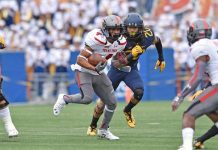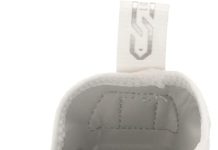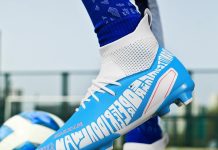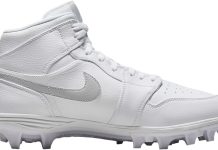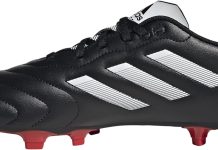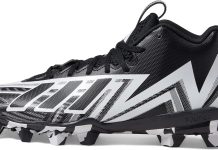Today, we are going to explore the intriguing world of cleats and uncover the differences that exist among them.
From the soccer field to the baseball diamond and even on the golf course, cleats are an essential piece of footwear designed to provide traction and stability.
But what sets them apart from one another? Join us as we discover the nuances and distinctions between cleats, unraveling the mystery behind their unique features and functionalities.
Materials
When choosing the right cleats, one of the first things to consider is the material they are made of. Different materials offer different benefits and suit different playing conditions.
Review contents
Rubber cleats
Rubber cleats are a popular choice for their versatility and affordability. They provide good traction on most playing surfaces and suit firm and soft ground. They are also lightweight, making them comfortable to wear for long periods. However, rubber cleats may not be as durable as other materials and may wear down quickly.
Plastic cleats
Plastic cleats are another standard option for soccer players. They are lightweight and offer good traction on most surfaces. Plastic cleats are generally more durable than rubber cleats, making them an excellent choice for players who regularly play on rough or abrasive surfaces. However, plastic cleats may not provide as much grip on wet or slippery surfaces.
Metal cleats
Metal cleats are often the go-to choice for professional players or those who need maximum traction. Metal cleats offer excellent grip on firm ground surfaces, such as natural grass, and provide stability during quick movements. They are highly durable and can withstand heavy use, but they are not recommended for use on artificial turf or indoor surfaces as they can cause damage.
Surface Compatibility
Choosing the correct type of cleats based on the playing surface is crucial for optimal performance and safety. Here are the different types of cleats based on surface compatibility:
Firm ground cleats
Firm ground cleats, sometimes called FG cleats, are designed for use on natural grass surfaces that are neither hard nor soft. The studs on firm ground cleats are shorter and evenly distributed to provide traction without compromising stability.
Soft ground cleats
Soft ground or SG cleats are designed for playing on wet or muddy fields. They have longer and more widely spaced studs that penetrate the soft ground, providing better grip and preventing the player from slipping.
Artificial turf cleats
Artificial turf cleats, commonly called AG cleats, have shorter, more numerous studs to distribute pressure and provide traction on artificial grass surfaces. These cleats are specifically designed to prevent the turf from ripping or tearing.
Indoor cleats
Indoor cleats, IC cleats, or indoor soccer shoes are designed for indoor courts or hard surfaces. They have flat rubber soles that provide excellent grip on smooth surfaces and allow for quick movements and changes in direction.
Traction
Traction is a crucial factor to consider when choosing cleats. The type of cleat design can affect your ability to maneuver on the field. Let’s explore the different types of cleat traction:
Molded cleats
Molded cleats have studs or blades permanently attached to the shoe’s outsole. They provide reliable traction on most playing surfaces, including firm ground and some artificial turf. Molded cleats are popular among recreational players and beginners, as they offer a balance of grip, stability, and versatility.
Detachable cleats
Detachable cleats, also known as screw-in or stud cleats, allow players to customize their traction by swapping out different types and lengths of studs. This feature is handy for players who frequently play on different surfaces or in varying weather conditions. Professional players commonly use detachable cleats, as they offer the most versatility and the ability to adapt to specific playing conditions.
Bladed cleats
Bladed cleats have thinner, elongated studs that resemble blades. They provide excellent traction and allow for quick movement and acceleration. Bladed cleats are often preferred by players prioritizing speed and agility on the field.
Fit
The fit of your cleats can significantly impact your performance and comfort. Choosing a style that suits your foot shape and playing style is important. Here are the different types of cleat fit:
Low-top cleats
Low-top cleats, or low-cut cleats, provide a lightweight and minimalistic design. They offer maximum mobility and flexibility, allowing players to have unrestricted movement. Low-top cleats are ideal for players who prioritize speed and agility over ankle support.
Mid-cut cleats
Mid-cut cleats provide a balance between mobility and ankle support. They offer a slightly higher collar that covers the ankle and provides a snug fit. Mid-cut cleats are popular among players who want a bit more stability without sacrificing too much mobility.
High-top cleats
High-top cleats, or high-cut cleats, provide the most ankle support and stability. They have a higher collar that extends above the ankle, preventing excessive ankle rolling. High-top cleats are commonly chosen by players with a history of ankle injuries or require additional support during aggressive play.
Weight
The weight of your cleats can affect your performance and overall comfort on the field. Finding the right balance between lightweight design and necessary features is crucial. Let’s explore the different weight categories of cleats:
Lightweight cleats
Lightweight cleats are designed to be as light as possible without compromising performance and durability. These cleats are ideal for players who value speed and agility. Lightweight cleats allow quick movements and reduce fatigue during long matches or training sessions.
Midweight cleats
Midweight cleats offer a balance between lightweight design and added features. They provide moderate durability and support while still being comfortable to wear for extended periods. Midweight cleats are suitable for players who want a good balance of speed, support, and durability.
Heavyweight cleats
Heavyweight cleats are designed with added padding and reinforcements, making them the most durable and supportive option. These cleats provide maximum protection and durability but are also the heaviest option. Heavyweight cleats are commonly chosen by players who prioritize durability and physicality over speed.
Ankle Support
Ankle injuries can be a common occurrence in soccer, so having proper ankle support is crucial. Here are the different types of cleats based on ankle support:
Low-profile cleats
Low-profile or low-cut cleats prioritize mobility and freedom of movement over ankle support. They have a low collar that provides minimal coverage around the ankle. These cleats are ideal for players with stable ankles or who prefer a more natural range of motion.
Supportive cleats
Supportive cleats offer a mid-cut collar that provides moderate ankle support and stability. They are designed to minimize the risk of ankle injuries while allowing for a good range of motion. Supportive cleats suit players who want a balance between mobility and ankle protection.
Ankle brace-compatible cleats
Ankle brace-compatible cleats are designed with additional space inside the shoe to accommodate ankle braces. They provide a snug, supportive fit that helps secure the brace and offers extra protection. These cleats are ideal for players with a history of ankle injuries or require additional support.
Comfort
Comfort is an important aspect to consider when choosing cleats. Not only does comfortable footwear enhance performance, but it also reduces the risk of blisters and discomfort during games. Here are some factors to consider when evaluating cleat comfort:
Cushioned cleats
Cushioned cleats have extra padding and cushioning inside the shoe to provide a plush, comfortable feel. They help absorb impact and reduce pressure on the feet, making them a good choice for players who value comfort and shock absorption. Cushioned cleats are particularly beneficial for players with sensitive feet or prone to blisters.
Breathable cleats
Breathable cleats are designed with materials that allow air to circulate, keeping the feet cool and dry during games. They often have mesh panels or perforations that promote airflow and prevent excessive sweating. Breathable cleats are an excellent option for players who play in hot or humid climates or tend to sweat excessively.
Flexible cleats
Flexible cleats are made with materials that provide a good range of motion and allow for natural foot movement. They are designed to be supple and bend easily, allowing players to feel more in control of their movements. Flexible cleats are ideal for players who value agility and responsiveness on the field.
Durability
Durability is an essential factor to consider, especially if you play regularly or on harsh playing surfaces. Here are the different aspects of cleat durability:
Long-lasting cleats
Long-lasting cleats are built to withstand heavy use and extended playing time. They are made with high-quality materials that resist wear and tear, ensuring they can withstand the demands of the game. These cleats are a good investment for players who play frequently and want a reliable option that will last.
Durable outsoles
Durable outsoles are essential for ensuring the cleats can withstand various playing conditions. The outsoles should be made from tough and resilient materials that can handle rough surfaces without wearing down quickly. Cleats with durable outsoles are an excellent option for players who frequently play on abrasive surfaces.
Reinforced upper materials
Reinforced upper materials protect the cleats from damage and extend their lifespan. Materials such as synthetic leather or Kevlar are commonly used to reinforce the areas of the cleats that are exposed to the most stress, such as the toe box or sides. Cleats with reinforced upper materials provide enhanced durability and resistance to tearing.
Price
Cleat prices vary greatly depending on the brand, materials used, and additional features. Here are the different price categories of cleats:
Budget cleats
Budget cleats are generally more affordable and offer basic features and materials. While they may not have all the bells and whistles of higher-end cleats, they can still provide adequate performance for recreational or beginner players. Budget cleats are an excellent option for those on a tight budget or just starting.
Mid-range cleats
Mid-range cleats offer a balance between performance and affordability. They often incorporate advanced features and materials while maintaining a reasonable price point. Mid-range cleats are a popular choice among intermediate players who want a higher level of performance without breaking the bank.
Premium cleats
Premium cleats are the top-of-the-line options with the latest technologies, premium materials, and innovative designs. They are often used by professional players or those who demand the highest level of performance. Premium cleats come with a higher price tag, but the investment is worth it for serious athletes.
Brands
Different brands offer their unique characteristics and styles. Here are some popular brands known for their quality cleats:
Nike cleats
Nike is one of the world’s most recognizable and reputable sports brands. They offer a wide range of cleats that cater to players of all levels and playing styles. Nike cleats are known for their cutting-edge technologies, innovative designs, and exceptional performance.
Adidas cleats
Adidas is another renowned sports brand that produces high-quality cleats. They are known for their stylish designs, comfortable fit, and durability. Adidas cleats often feature advanced technologies that enhance performance and offer excellent traction on various surfaces.
Puma cleats
Many players belove puma cleats for their unique style and comfortable fit. Puma focuses on delivering cleats that prioritize agility and responsiveness on the field. Their cleats often incorporate lightweight materials and innovative technologies to maximize performance.
Under Armour cleats
Under Armour is a brand known for its commitment to performance and innovation. Their cleats are designed to provide superior comfort, support, and durability. Under Armour cleats often feature cutting-edge materials and technologies that enhance performance in various playing conditions.
New Balance cleats
New Balance is a brand that prides itself on producing cleats with excellent comfort and support. They offer a range of cleats that cater to different foot shapes and playing styles. New Balance cleats are often commended for their quality craftsmanship and attention to detail.




